Striker-fired pistols have become increasingly popular among both law enforcement and civilian shooters. But what exactly is a striker-fired pistol, and what makes it different from other types of handguns? This comprehensive guide will delve into the mechanics, advantages, disadvantages, and popular examples of this firearm design.
Understanding the Striker Mechanism
Unlike pistols that use a hammer to strike the firing pin (hammer-fired pistols), striker-fired pistols utilize a spring-loaded firing pin, or "striker," that is directly impacted by the trigger. When the trigger is pulled, the striker is released, impacting the primer of the cartridge and causing it to fire. This eliminates the intermediate step of a hammer impacting the firing pin.
Key Components of a Striker-Fired Pistol:
- Striker: The spring-loaded firing pin that directly ignites the cartridge.
- Trigger: The mechanism that releases the striker. In many designs, the trigger itself contains the striker's release mechanism.
- Trigger Bar: Connects the trigger to the striker release mechanism.
- Striker Spring: Compresses the striker and provides the force needed for ignition.
Advantages of Striker-Fired Pistols
Several factors contribute to the popularity of striker-fired pistols:
- Simplicity: The simpler mechanism often translates to fewer parts, leading to enhanced reliability and easier maintenance. Fewer parts mean fewer potential points of failure.
- Lightweight Design: Often, striker-fired pistols are lighter than their hammer-fired counterparts, enhancing maneuverability and reducing fatigue during extended use.
- Safe Carry: Many models feature passive safety mechanisms integrated into the trigger design, preventing accidental discharge, even if dropped. These integrated safeties are often considered more intuitive than manual safeties found on hammer-fired pistols.
- Improved Trigger Pull (In some models): While trigger pull characteristics can vary widely between manufacturers and models, some find the trigger pull on striker-fired pistols to be smoother and more consistent.
- Cost-Effectiveness: The simpler design often results in lower manufacturing costs, making them a more budget-friendly option for many shooters.
Disadvantages of Striker-Fired Pistols
While striker-fired pistols offer numerous advantages, they also have some drawbacks:
- Trigger Safety: While many designs incorporate passive safety features, some shooters feel less comfortable with the lack of a manual safety.
- Trigger Pull Consistency: While often lauded for smoothness, the trigger pull consistency can vary, and a heavier or less predictable trigger pull might be a disadvantage for some shooters.
- Potential for Accidental Discharge (In rare cases): Although rare, improper handling or modifications could potentially lead to accidental discharges. It is crucial to always adhere to safe firearm handling practices.
Popular Examples of Striker-Fired Pistols
Numerous manufacturers produce striker-fired pistols, including:
- Glock: Known for its innovative designs and reliability.
- Smith & Wesson M&P: A popular choice among law enforcement and civilians.
- SIG Sauer P320: A modular pistol system with various configurations.
- Springfield XD/XD-S: Offering a range of sizes and calibers.
- FN 509: A full-sized pistol known for its accuracy and ergonomics.
Conclusion
Striker-fired pistols represent a significant advancement in handgun technology. Their simplicity, reliability, and often lighter weight have made them a favored choice for many. However, potential users should carefully consider the advantages and disadvantages and select a model that best suits their individual needs and shooting style. Always prioritize proper firearm safety training and responsible gun ownership.

